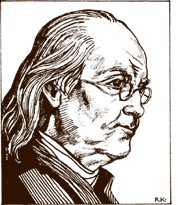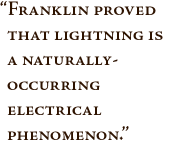

by Steve Graham • August 8, 1999  While popularly known for his role as
one of the United States’ founding fathers, Benjamin Franklin was also a
renowned scientist who made a number of substantial contributions in the
field of Earth science. Affectionately known as Dr. Franklin (even
though he never received his Ph.D.), he published numerous scientific
papers—mostly on electricity. Franklin became a scientist because he
was insatiably curious about the world around him. He wanted to know how
things worked and figure out ways to make them better. While popularly known for his role as
one of the United States’ founding fathers, Benjamin Franklin was also a
renowned scientist who made a number of substantial contributions in the
field of Earth science. Affectionately known as Dr. Franklin (even
though he never received his Ph.D.), he published numerous scientific
papers—mostly on electricity. Franklin became a scientist because he
was insatiably curious about the world around him. He wanted to know how
things worked and figure out ways to make them better.
In 1743, Franklin compared weather observations in letters he received from friends in other colonies. He was one of the first to observe that North American storms tend to move from west to east, and predicted that a storm's course could be plotted. He even made some of the first-recorded weather forecasts in his Poor Richard’s Almanac, a 25-year publication that Franklin first published in 1732 under the pseudonym of Richard Saunders.
|
 On the Shoulders of Giants
Images
Bottom: Franklin and his son, William, performing their legendary experiment in the midst of a thunderstorm. Courtesy Library of Congress | ||